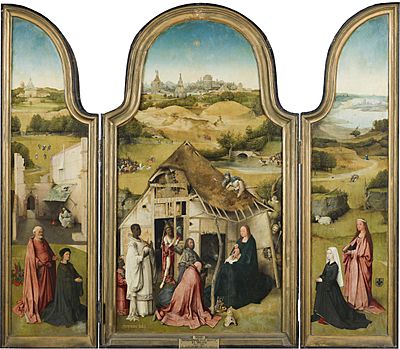Adoration of the Magi (Bosch, Madrid) facts for kids
Quick facts for kids Adoration of the Magi |
|
|---|---|
 |
|
| Artist | Hieronymus Bosch |
| Year | c. 1485-1500 |
| Medium | Oil on panel |
| Dimensions | 138 cm × 144 cm (54 in × 57 in) |
| Location | Museo del Prado, Madrid |
The Adoration of the Magi is a famous triptych (a painting with three panels) made by the Dutch artist Hieronymus Bosch. He painted it between about 1485 and 1500. Today, you can see this oil painting at the Museo del Prado in Madrid, Spain. It shows the story of the Three Wise Men (Magi) visiting baby Jesus.
Contents
Painting's Journey
Around 1494, a wealthy couple from Antwerp, Peeter Scheyfve and Agnes de Gramme, asked Bosch to create this painting. It was meant to be an altarpiece, a special artwork for a church altar.
For a long time, the painting was kept at the El Escorial monastery in Spain. In 1605, someone described it as an "Epiphany without any extravaganza," meaning it was different from Bosch's other, more unusual works. Since 1839, it has been part of the collection at the Prado Museum.
Scientists have studied the wood panels used for the painting. They found that the wood was ready to be used after 1472, most likely after 1474. This helps us know when the painting was made.
What the Painting Shows
This painting is a triptych, which means it has three parts that can open and close like a book.
The Closed Panels
When the triptych is closed, you see a painting in shades of gray, called grisaille. This scene shows Mass of Saint Gregory. It features Gregory the Great kneeling at an altar, looking at Christ. Christ is surrounded by angels. The two people painted in color on these gray panels were added later; they are the people who paid for the painting.
The frame around this scene shows other moments from the Life of Jesus. Starting from the bottom left, you can see:
- The Prayer in the Garden
- The Arrest
- Christ in Front of Pilatus
- The Flagellation (where Jesus is whipped)
- The Coronation of Thorns (where Jesus is given a crown of thorns)
- The Via Crucis (Jesus carrying the cross)
- Finally, the Crucifixion
In the sky around the cross, there's an angel flying and a devil with a red halo. The devil is pulling away the soul of Judas Iscariot. You can also see Judas hanging from a tree on the right side of a mountain, with a man pointing at him.
The Side Panels
When the triptych is open, you see three colorful panels.
The left panel shows Saint Peter and one of the people who paid for the painting, Peeter Scheyfve. You can see his family symbol, called a coat of arms, with the words "Een voer al" (meaning "One for all"). In the background, a man sits on a basket under a simple roof. This is likely Saint Joseph, who is warming Jesus' diapers.
The right panel shows Saint Agnes and the other person who paid for the painting, Agnes de Gramme. She also has her family's coat of arms. In the background, you can see a bear and a wolf attacking some people.
The Main Central Panel
The central panel shows the Adoration of the Magi, which is a traditional scene. A large Mary sits outside a simple hut, holding baby Jesus.
Melchior, the oldest of the Wise Men, is kneeling at Mary's feet. He has brought a special gift: a golden sculpture showing the Sacrifice of Isaac. This scene from the Bible is a hint of Jesus' future suffering. Below the gift, there are some toads, which were sometimes seen as symbols of false beliefs. Melchior's crown is on the ground, showing that earthly power is not as important as heavenly power.
Caspar stands behind Melchior. His cloak has a picture of the Queen of Sheba visiting King Solomon. He brings frankincense, a type of incense, in a beautiful container.
Finally, the last Wise Man is Balthazar, who has dark skin. He wears white clothes decorated with patterns that look like thorny leaves. He brings a round container called a pyx, which has carvings showing King David being offered water. This container holds myrrh, another precious gift. Balthazar is with a dark-skinned servant.
There's an unusual figure at the entrance of the hut. This person is partly unclothed and surrounded by other strange-looking figures. They wear a red cloak and hold a crown-like object. They also have a mark on their left ankle, covered by glass. This mysterious figure has been interpreted in many ways, perhaps hinting at future events or different beliefs.
Other people in the painting include shepherds peeking into the hut, which was common in paintings of this time. You can also see armies in the distance and strange, almost human-like buildings.
Colors and Materials
Bosch used many of the same colors in this painting as he did in his other works. He used natural colors like ochres (yellows and browns), lead-tin-yellow, vermilion (a bright red), carmine (another red), and azurite (a blue). One interesting color he used, though only a little, was natural ultramarine for parts of the Virgin Mary's robe.
See also
 In Spanish: Adoración de los Magos (El Bosco) para niños
In Spanish: Adoración de los Magos (El Bosco) para niños
- List of paintings by Hieronymus Bosch
- Adoration of the Magi (Bosch, New York)
- Adoration of the Magi (Bosch, Philadelphia)
Images for kids




